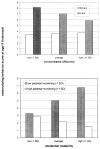Neighborhood structure, parenting processes, and the development of youths' externalizing behaviors: a multilevel analysis
- PMID: 12741688
- PMCID: PMC2764293
- DOI: 10.1023/a:1023018502759
Neighborhood structure, parenting processes, and the development of youths' externalizing behaviors: a multilevel analysis
Abstract
Associations among neighborhood structure, parenting processes, and the development of externalizing behavior problems were investigated in a longitudinal sample of early adolescents (from age 11 to 13). Mothers' reports of parental monitoring (at age 11), mothers' and youths' reports of the amount of youths' unsupervised time (at age 11), and youths' reports of positive parental involvement (at age 12) were used to predict initial levels (at age 11) and growth rates in youths' externalizing behavior as reported by teachers. Census-based measures of neighborhood structural disadvantage, residential instability, and concentrated affluence were expected to moderate the effects of parenting processes (e.g., parental monitoring) on externalizing behavior. Hierarchical linear modeling results revealed that less parental monitoring was associated with more externalizing behavior problems at age 11, and more unsupervised time spent out in the community (vs. unsupervised time in any context) and less positive parental involvement were associated with increases in externalizing behavior across time. Furthermore, the decrease in externalizing levels associated with more parental monitoring was significantly more pronounced when youths lived in neighborhoods with more residential instability.
Figures


References
-
- Aber JL. Poverty, violence, and child development: Untangling family and community level effects. In: Nelson CA, editor. Threats to optimal development: Integrating biological, psychological, and social risk factors, The Minnesota Symposia on Child Psychology. Vol. 27. Hillsdale, NJ: Erlbaum; 1994. pp. 229–272.
-
- Achenbach TM. Manual for the Teacher’s Report Form and 1991 Profile. Burlington, VT: University of Virlington, Department of Psychiatry; 1991.
-
- Aiken LS, West SG. Multiple regression: Testing and interpreting interaction. Newbury Park, CA: Sage; 1991.
-
- Aneshensel CS, Sucoff CA. The neighborhood context of adolescent mental health. Journal of Health and Social Behavior. 1996;37:293–310. - PubMed
-
- Ary DV, Duncan TE, Biglan A, Metzler CW, Noell JW, Smolkowski K. Development of adolescent problem behavior. Journal of Abnormal Child Psychology. 1999;27:141–150. - PubMed
Publication types
MeSH terms
Grants and funding
LinkOut - more resources
Full Text Sources
Medical

